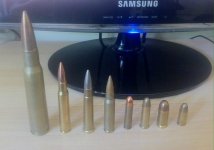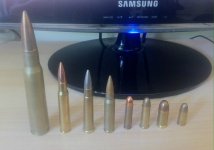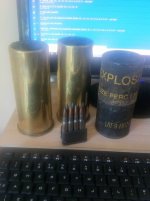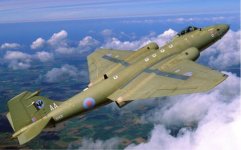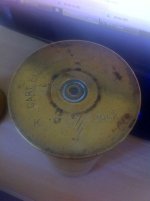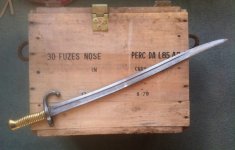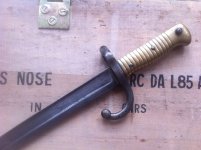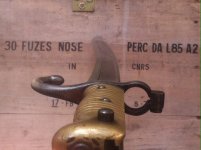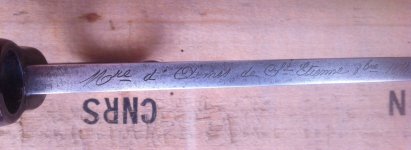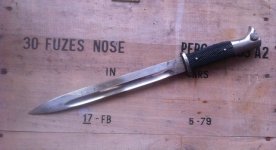The Militaria Thread: Pointy Stuff and Shooty Stuff
Hello chaps!
Being the manliest of men, here and there, bits and pieces of militaria, both modern and antique, can be found floating around our board, so I thought it'd be a dash good show if it was all collected into one handy package. So, in this thread, please post:
You get the idea! I have a small but growing collection of militaria dating from 1822 onwards: some edged weaponry, bullets, kit. Why collect this stuff? If you love history there is nothing - nothing - that comes close to owning, looking after and researching real items. Read all the books you want, watch all the TV shows you like; it's only when you pick up this stuff and turn it over in your hands that you can be transported back in time and, to some extent, understand what people had to endure. Secondly, money is a factor. They aren't making any more of this stuff and the price is rising steadily as the items in circulation slowly dwindle. I've seen items double in price in the last few years alone, and I know of people who consider their collections to be their pensions.
So, to kick off, here’s my M1891/30 Mosin Nagant.
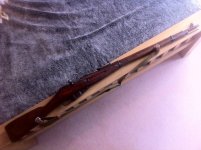
This was the main rifle used by the Russian infantry during the Second World War. This particular piece is dated 1936 and has been well used (with the date, it is enough to make me think it was used in anger). It’s covered with little markings and stamps – the meanings of most of which the Russians still haven’t released to us, but I can tell that it was made at the Ishevsk Armoury. It’s a long rifle, and heavy too – I’d hate to have to carry it around for extended periods. It must also have been near suicide to use it in the desperate house-to-house, floor-to-floor fighting of Stalingrad, and so on: you simply can’t wield it at all in close confines. This gun was replaced by the AK47, in the main.
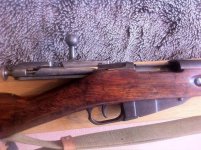
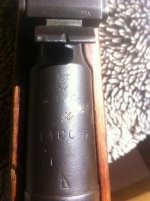
This particular rifle is deactivated to the standards set out in UK law. The bolt’s action works nicely, it can be cocked and it can be fully stripped, but the barrel and chamber are welded closed and the bolt head is cut. You only need to be 18 years old or over to own it.
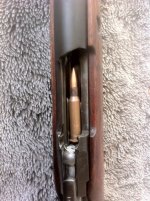
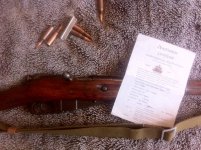
This is what it used to fire: 7.62x54r. As you can see, the cartridges were inserted into a five-round charger clip (stripper clip if you’re American), to make for faster reloading.
The bayonet is cruciform in shape and flat at the tip. It can be used to unscrew the two screws needed to field strip the whole rifle – Soviet simplicity at work!
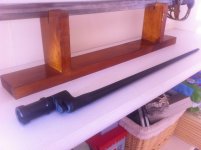
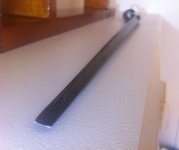
Any questions are welcome. I'll post other bits and bobs as the thread gets going, along with their history. Does anyone else have anything to post?
Hello chaps!
Being the manliest of men, here and there, bits and pieces of militaria, both modern and antique, can be found floating around our board, so I thought it'd be a dash good show if it was all collected into one handy package. So, in this thread, please post:
- Any items of noteworthy militaria you come across on your travels.
- Details of your collections, if you have any.
- Replicas, swords, ancient weapons, bombs, bullets, tanks - anything welcome.
- Items you've found or inherited that you would like help identifying.
You get the idea! I have a small but growing collection of militaria dating from 1822 onwards: some edged weaponry, bullets, kit. Why collect this stuff? If you love history there is nothing - nothing - that comes close to owning, looking after and researching real items. Read all the books you want, watch all the TV shows you like; it's only when you pick up this stuff and turn it over in your hands that you can be transported back in time and, to some extent, understand what people had to endure. Secondly, money is a factor. They aren't making any more of this stuff and the price is rising steadily as the items in circulation slowly dwindle. I've seen items double in price in the last few years alone, and I know of people who consider their collections to be their pensions.
So, to kick off, here’s my M1891/30 Mosin Nagant.

This was the main rifle used by the Russian infantry during the Second World War. This particular piece is dated 1936 and has been well used (with the date, it is enough to make me think it was used in anger). It’s covered with little markings and stamps – the meanings of most of which the Russians still haven’t released to us, but I can tell that it was made at the Ishevsk Armoury. It’s a long rifle, and heavy too – I’d hate to have to carry it around for extended periods. It must also have been near suicide to use it in the desperate house-to-house, floor-to-floor fighting of Stalingrad, and so on: you simply can’t wield it at all in close confines. This gun was replaced by the AK47, in the main.


This particular rifle is deactivated to the standards set out in UK law. The bolt’s action works nicely, it can be cocked and it can be fully stripped, but the barrel and chamber are welded closed and the bolt head is cut. You only need to be 18 years old or over to own it.


This is what it used to fire: 7.62x54r. As you can see, the cartridges were inserted into a five-round charger clip (stripper clip if you’re American), to make for faster reloading.
The bayonet is cruciform in shape and flat at the tip. It can be used to unscrew the two screws needed to field strip the whole rifle – Soviet simplicity at work!


Any questions are welcome. I'll post other bits and bobs as the thread gets going, along with their history. Does anyone else have anything to post?
Last edited:



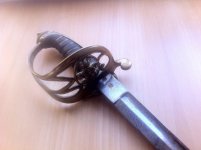
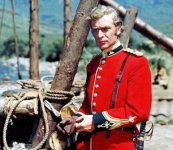
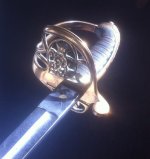
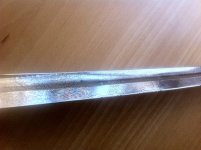
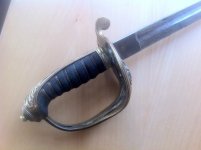
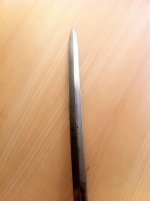
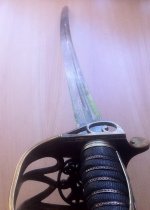


 The bolt action still works at least, and I can charge the magazine with a clip of inert rounds, and it dry fires.
The bolt action still works at least, and I can charge the magazine with a clip of inert rounds, and it dry fires.